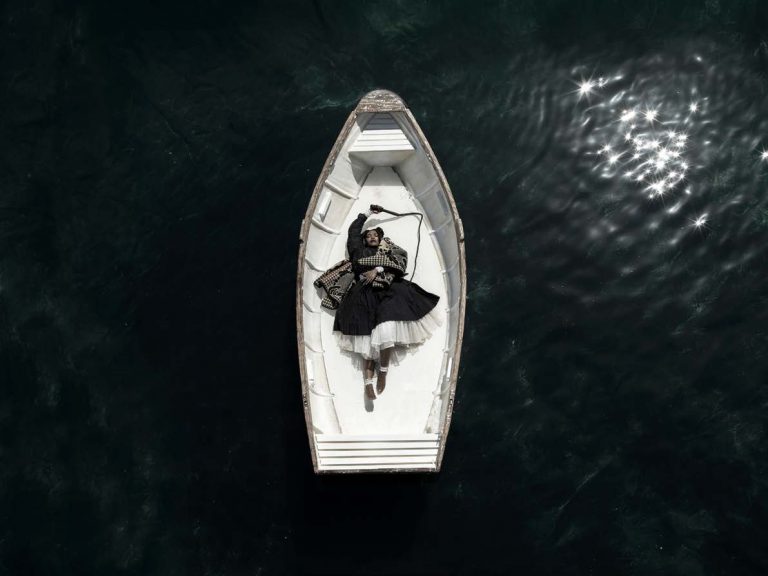Smadar Sheffi reviewed Mohau’s solo show in the gallery
Link to read the review on Smadar’s blog
“Mohau Modisakeng
The artworks by Mohau Modisakeng (b. 1986, Soweto, South Africa) are islands of beauty – restrained, attractive, and unashamedly theatrical. Themes of identity, racism, and exploitation reappear in his works, arising from the terrible history of Africa over the centuries, and South Africa in particular. His series consist of works that reinforce each other, formulating a language through a series of gestures in the photographic space, simultaneously structuring and denying it.
The three pieces titled Passage (2017) are especially strong, and were exhibited at the Venice Biennale that same year, at the South African pavilion. The photographs on view in the current exhibition, stills from the video work screened at the Biennale, take on autonomous meaning. All three photographs depict figures in boats, from an overhead point of view, all in dramatic, glistening, deep blacks and whites. The mirror-like surface reflects viewers who become swallowed up in the work, being made present in what seems like a ceremony. The immediate and necessary reading is in the context of emigration from Africa, as stated in the gallery text; and yet, in addition to this context, the additional layers in the work are mesmerizing, transforming them into much more than works of protest or lamenting about the current state of things and the terrible toll of the slave trade on Africa. There are fascinating associations to artists such as Beuys, James Lee Byars, as well as Bill Viola and perhaps Marina Abramovic.
The boats (identical in all three photographs) create a halo enveloping the figures like the space depicted around saints. The boats have become transformed into ships of redemption, or death, or perhaps rescue vessels like Baby Moses’s basket on the Nile (with its memory of Noah’s Ark). Each boat bears a single figure, in contrast to depictions of refugee boats, or crowded slave ships, as portrayed by many artists in recent years who based their works on old photographs or actually incorporated old documents. Modisakeng places his figures in a symbolic reality, making them into heroes in the Odyssean tradition of the external journey as metaphor for the internal quest.
In Passage 4, a man wearing a black suit and a hat is in the boat with an eagle flying above him. The huge shadow of the very regal bird of prey rests on the boat alongside of the shadow of the man who looks as if he is dancing, grasping a rope tied to the boat as if he is controlling its movement (or attempting control). This is a charged situation: a man in the uniform/clothing of power and of western culture is in an unclear relationship with the eagle – the symbol of numerous western and non-western institutions of power. Modisakeng activates a series of associations, from the place of the eagle in western culture, here casting a threatening shadow on a Black man through the (problematic and partial) link to Freud’s psychoanalytic engagement with Leonardo da Vinci’s childhood memory of a vulture (often confused with the eagle) whose tail caressed his mouth, through to the eagle as hunting bird in many areas of Asia. The man’s relationship with the bird, between rowing and flight, the lost feeling of the boat, and the intended large scope of the bird’s flight open up multiple layers in the work.
At the center of the triptych, in the work named Passage 8, a woman is lying down in the boat, her eyes closed, in a state of sleep, death, or introspection. Above her head she is holding or waving a long whip, which becomes a dead line in the supine position. The enigmatic woman is dressed like a Victorian servant or perhaps wearing bourgeois clothing from a non-specific past era. Over them a blanket/shawl stands out, patterned with plants and checks, seemingly taken from a different aesthetic world. The dream state, the state of consciousness which is other than the state of daily life, returns in Passage 6 as well, on the right side of the triptych featuring a man lying down in a boat full of water. His wet clothes wrap his floating body like the robe in paintings of transfigurations. The face above water leaves room for ambivalence regarding the issue of whether the figure is dead or alive. The requisite umbrella for such a figure, and Modiskeng’s theatricality, calls for a closer look at the objects in his oeuvre; the umbrella looks like a gun, or arrow, but, being an umbrella. it looks absurd and pathetic since it is saturated with sea water.
The triptych can be read as a proposal for reincarnation or metamorphosis, like the name of another work by the artist. The masculine and the feminine, the animal, the hunger and hunted are in a state of rootlessness and anxiety. The dark waters of the sea surrounding the boat – the container of conflicted consciousness – changes into water with ripples and lights near the boat where a woman is lying down, near bubbles of foam. The woman in the third photograph in the triptych seems to have drowned. The viewer’s encounter with the Ego in these works leaves no room for avoidance of the subversive experience challenging the basic divisions of consciousness.
Curator: Adi Gura
Braverman Gallery, Eilat 33, Tel Aviv

Sunday
Monday
Tue – Thu
Friday
Saturday
Closed
By appointment only
11:00 – 18:00
11:00 – 14:00
11:00 – 14:00
Design by The-Studio
Code By Haker Design
Sunday
Monday
Tue – Thu
Friday
Saturday
Closed
By appointment only
11:00 – 16:00
11:00 – 14:00
Closed